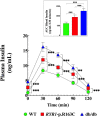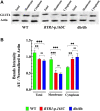Chronic Elevation of Skeletal Muscle [Ca2+]i Impairs Glucose Uptake. An in Vivo and in Vitro Study
- PMID: 35547584
- PMCID: PMC9083325
- DOI: 10.3389/fphys.2022.872624
Chronic Elevation of Skeletal Muscle [Ca2+]i Impairs Glucose Uptake. An in Vivo and in Vitro Study
Abstract
Skeletal muscle is the primary site of insulin-mediated glucose uptake through the body and, therefore, an essential contributor to glucose homeostasis maintenance. We have recently provided evidence that chronic elevated intracellular Ca2+ concentration at rest [(Ca2+)i] compromises glucose homeostasis in malignant hyperthermia muscle cells. To further investigate how chronic elevated muscle [Ca2+]i modifies insulin-mediated glucose homeostasis, we measured [Ca2+]i and glucose uptake in vivo and in vitro in intact polarized muscle cells from glucose-intolerant RYR1-p.R163C and db/db mice. Glucose-intolerant RYR1-p.R163C and db/db mice have significantly elevated muscle [Ca2+]i and reduced muscle glucose uptake compared to WT muscle cells. Dantrolene treatment (1.5 mg/kg IP injection for 2 weeks) caused a significant reduction in fasting blood glucose levels and muscle [Ca2+]i and increased muscle glucose uptake compared to untreated RYR1-p.R163C and db/db mice. Furthermore, RYR1-p.R163C and db/db mice had abnormal basal insulin levels and response to glucose-stimulated insulin secretion. In vitro experiments conducted on single muscle fibers, dantrolene improved insulin-mediated glucose uptake in RYR1-p.R163C and db/db muscle fibers without affecting WT muscle fibers. In muscle cells with chronic elevated [Ca2+]i, GLUT4 expression was significantly lower, and the subcellular fraction (plasma membrane/cytoplasmic) was abnormal compared to WT. The results of this study suggest that i) Chronic elevated muscle [Ca2+]i decreases insulin-stimulated glucose uptake and consequently causes hyperglycemia; ii) Reduced muscle [Ca2+]i by dantrolene improves muscle glucose uptake and subsequent hyperglycemia; iii) The mechanism by which chronic high levels of [Ca2+]i interfere with insulin action appears to involve the expression of GLUT4 and its subcellular fractionation.
Keywords: GLUT4; calcium; dantrolene; diabetes; skeletal muscle.
Copyright © 2022 Uryash, Mijares, Lopez, Adams and Lopez.
Conflict of interest statement
Author CL was employed by Wellmax Medical Center. The remaining authors declare that the research was conducted in the absence of any commercial or financial relationships that could be construed as a potential conflict of interest.
Figures







Similar articles
-
Impairment of Glucose Uptake Induced by Elevated Intracellular Ca2+ in Hippocampal Neurons of Malignant Hyperthermia-Susceptible Mice.Cells. 2024 Nov 15;13(22):1888. doi: 10.3390/cells13221888. Cells. 2024. PMID: 39594636 Free PMC article.
-
T lymphocytes from malignant hyperthermia-susceptible mice display aberrations in intracellular calcium signaling and mitochondrial function.Cell Calcium. 2021 Jan;93:102325. doi: 10.1016/j.ceca.2020.102325. Epub 2020 Dec 1. Cell Calcium. 2021. PMID: 33310301 Free PMC article.
-
Pharmacologic and functional characterization of malignant hyperthermia in the R163C RyR1 knock-in mouse.Anesthesiology. 2006 Dec;105(6):1164-75. doi: 10.1097/00000542-200612000-00016. Anesthesiology. 2006. PMID: 17122579
-
Heparin impairs skeletal muscle glucose uptake by inhibiting insulin binding to insulin receptor.Endocrinol Diabetes Metab. 2021 May 5;4(3):e00253. doi: 10.1002/edm2.253. eCollection 2021 Jul. Endocrinol Diabetes Metab. 2021. PMID: 34277977 Free PMC article.
-
Effects of hyperglycemia on glucose transporters of the muscle: use of the renal glucose reabsorption inhibitor phlorizin to control glycemia.J Am Soc Nephrol. 1992 Nov;3(5):1078-91. doi: 10.1681/ASN.V351078. J Am Soc Nephrol. 1992. PMID: 1482748 Review.
Cited by
-
Mutations in proteins involved in E-C coupling and SOCE and congenital myopathies.J Gen Physiol. 2022 Sep 5;154(9):e202213115. doi: 10.1085/jgp.202213115. Epub 2022 Aug 18. J Gen Physiol. 2022. PMID: 35980353 Free PMC article. Review.
-
Enhancing Muscle Intracellular Ca2+ Homeostasis and Glucose Uptake: Passive Pulsatile Shear Stress Treatment in Type 2 Diabetes.Biomedicines. 2023 Sep 22;11(10):2596. doi: 10.3390/biomedicines11102596. Biomedicines. 2023. PMID: 37892970 Free PMC article.
-
Skeletal muscle disorders as risk factors for type 2 diabetes.Mol Cell Endocrinol. 2025 Apr 1;599:112466. doi: 10.1016/j.mce.2025.112466. Epub 2025 Jan 21. Mol Cell Endocrinol. 2025. PMID: 39848431 Review.
-
Calcium trafficking and gastrointestinal physiology following an acute lipopolysaccharide challenge in pigs.J Anim Sci. 2024 Jan 3;102:skae073. doi: 10.1093/jas/skae073. J Anim Sci. 2024. PMID: 38483214 Free PMC article.
-
Nitric oxide in modulating oxidative stress mediated skeletal muscle insulin resistance.Mol Biol Rep. 2024 Aug 29;51(1):944. doi: 10.1007/s11033-024-09874-y. Mol Biol Rep. 2024. PMID: 39210004 Review.
References
LinkOut - more resources
Full Text Sources
Miscellaneous

